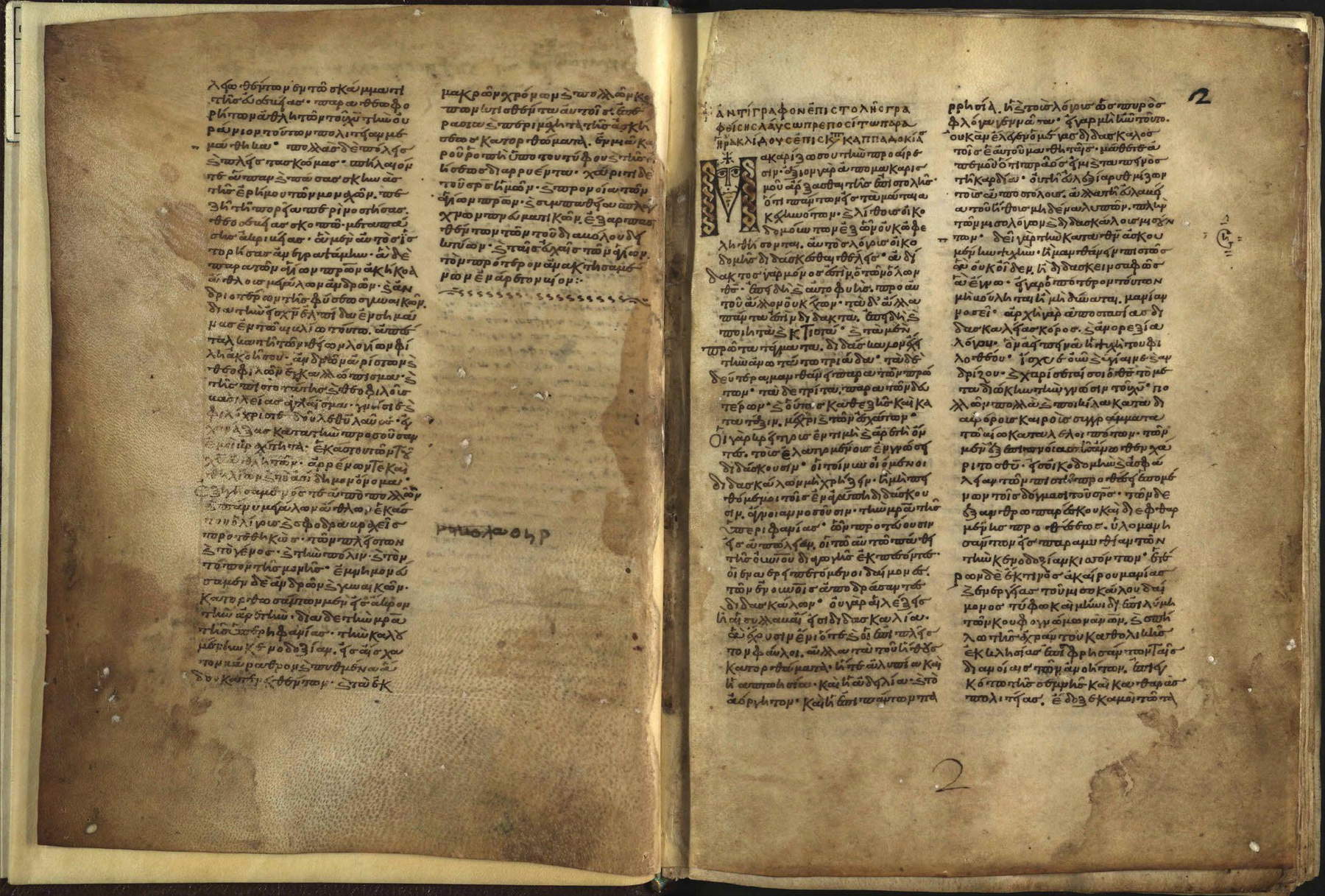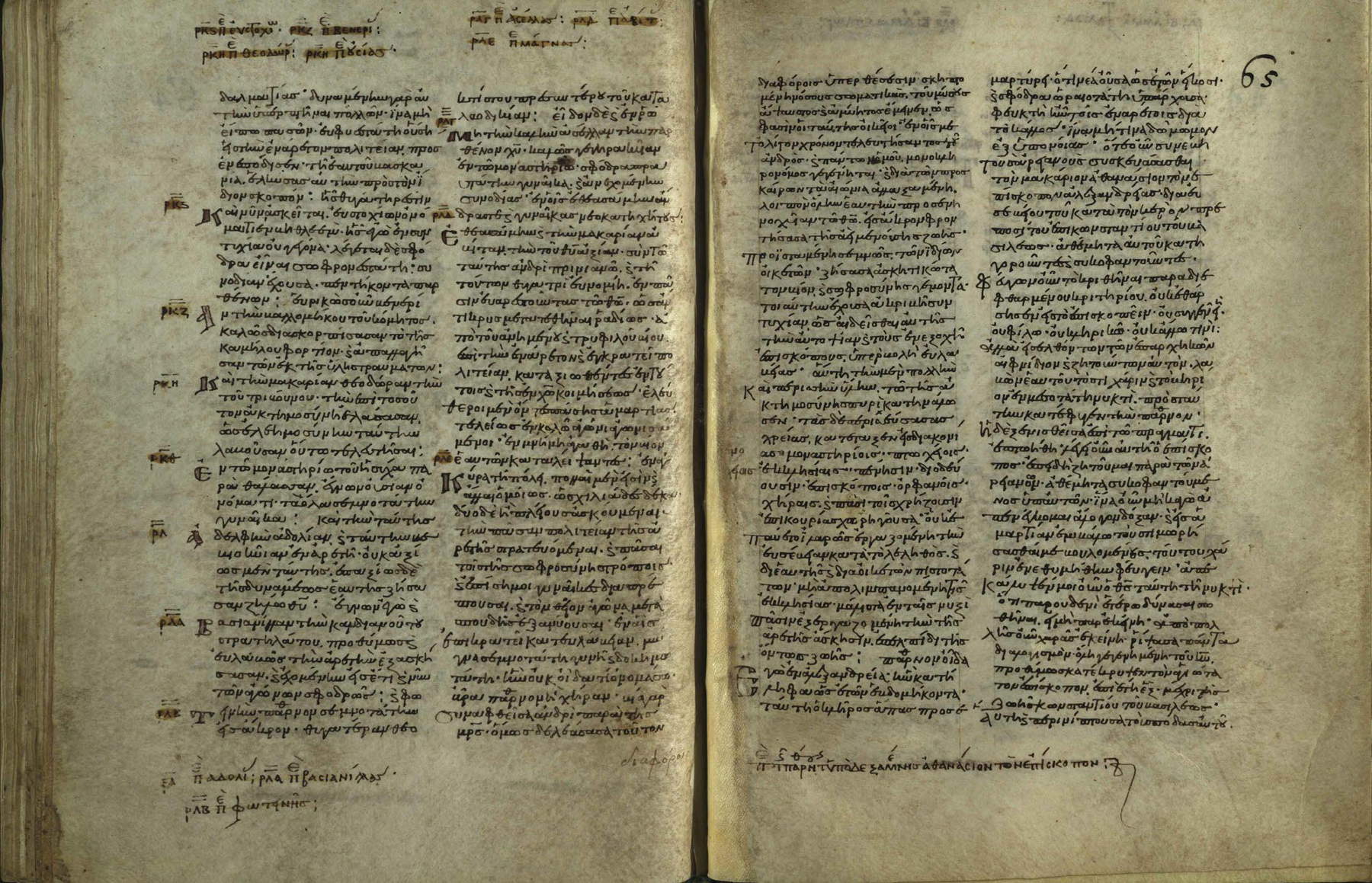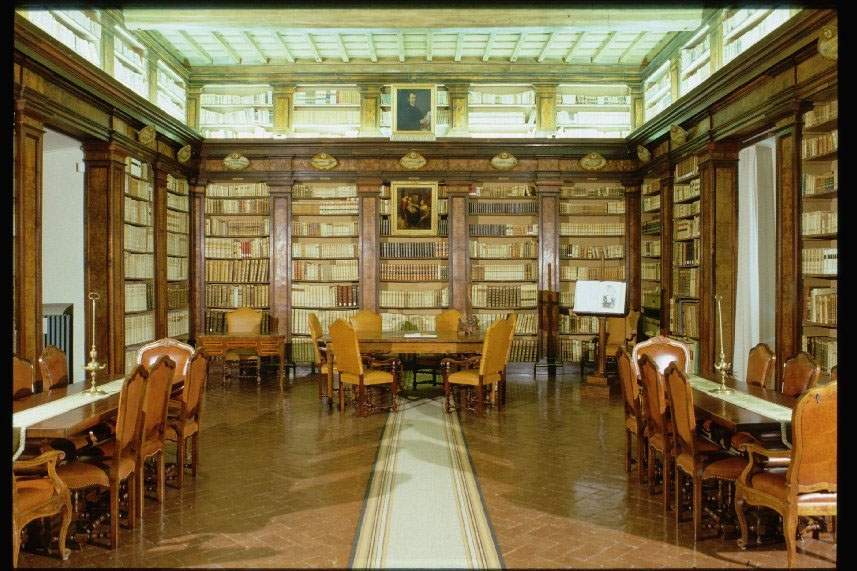TheAbbey of Santa Maria di Grottaferrata holds a singular record: it is thelast survivingmedieval Byzantine monastery in Italy. It is in fact famous, wrote Giovanna Falcone, director of the Library of the National Monument of Grottaferrata, “for being the custodian of the Byzantine spiritual and cultural tradition in the West, witnessed by the ritual and the heritage of manuscript and printed works that it preserves.” The Grottaferrata monastery was founded in 1004 by two Italo-Greek monks, Nilus of Rossano (Rossano, 910 - Tusculum, 1004) and Bartholomew of Rossano (Rossano, 981 - Grottaferrata, 1055), who also supervised the construction work.
Nilus, venerated today as a saint by both the Catholic and Orthodox Churches, was the abbot of the new monastery founded in the hills of Tusculum, over the remains of a Roman villa that tradition believed to be the site of an apparition of Our Lady, and he had brought with him a number of texts necessary for the conduct of the liturgies, for the ascetic practices of the monks and for their spiritual formation. These were partly texts copied by the monks themselves, some of them even by St. Nilus himself, who was a highly regarded copyist at the time (the paleographer Sofronio Gassisi spoke of a “Nilian school of calligraphy”: what seems almost certain, however, is that Nilus’ scriptorium followed him in all his travels, since an interesting book production flourished in all the monasteries he founded or in which he worked). Precisely the Library of the National Monument in Grottaferrata preserves the three autograph manuscripts of St. Nilus: these are three works copied around the year 965 (the date is taken from a piece of news in one of the codices, that of the Arab conquest of the city of Rometta in Sicily, which took place that very year), which contain important texts of the ascetic-spiritual literature of the Mediterranean East.


To best understand its contents, we need to frame the culture of St. Nilus, a monk of great erudition, whose activity was always very industrious throughout his life: he was familiar with the ascetic writings of St. Maximus the Confessor, St. John Chrysostom, the works of Gregory of Durazo, the Historia Lausiaca of Palladius of Galatia, the Ecclesiastical History of Theodoret, theApocalypse of Simeon the Stylite, and the dialogues of Gregory the Great. We derive the horizon of his interests from the writings that were copied by his monks or by himself, but due to lack of in-depth information we cannot thoroughly investigate his culture, which we can imagine, however, ranged over many fields, not least because some of his letters have remained with us, and some of his poetic compositions also survive. And this culture was then reflected in the daily life of his monastic community: Nilus taught his monks not only the mystical disciplines but also how to read and write, for example.
Moreover, every monastery, whether in the East or the West, from its foundation had its own collection of books and, almost always, was itself a producer of them. The monastery of Grottaferrata fits into the tradition of the monasteries of the Byzantine East and southern Italy and, as mentioned, is the’sole survivor of the many Italo-Hellenic monastic settlements that were located in central-southern Italy between the 10th and 11th centuries, and today holds lla responsibility for representing and preserving in Latin lands the Byzantine tradition and a part of its own book production, together with that of monasteries that have now disappeared. So, even before the founding of the Grottaferrata Monastery, the community organized and directed by St. Nilus necessarily possessed its own set of books, which he brought with him when he came to settle in the Tuscolan.


As for his activity as a copyist, the few remaining traces are contained in the autographs of St. Nilus in the Library of the National Monument in Grottaferrata. The three codices, marked as B.α.XIX, B.α.XX and B.β.I contain, respectively, the ascetical writings of Blessed Mark and Blessed Diadochus, and a discourse of Basil of Selencia (the Contra Judeos); the Doctrinal Discourses of St. Dorotheus Abbot, the sermon Comparatio regis et monachi of St. John Chrysostom, and De Eutaxia Metropolitan Theodore of Durazzo (the latter work, however, was not transcribed by St. Nilus); the Historia Lausiaca of Palladius of Galatia, bishop of Elenopolis and friend of John Chrysostom (as well as a disciple of Evagrius Ponticus), a work that offers, in the form of short discourses, news and facts about holy men and women, and a work considered to be a source of first importance for the history of monasticism, inspired by the Vita Antonii of Athanasius of Alexandria, which enjoyed wide circulation in the ancient world. We can be certain of their authorship because in B.α.XIX the acrostic signature of Nilus (who wrote in Greek) appears: the letters that make up the word NEΛOY constitute the beginning of the verses of an epigram.
All three codices are written on parchment. The first codex, B.α.XIX, contains 87 folios: except for four folios, these are always quaternions, i.e., large fascicles of four folios each, measuring 25 centimeters in height and 19 centimeters in width. 25 cm. high, 19 cm. wide. The codex is double-columned, almost each consisting of thirty-six lines, in bound, dense, compound, correct typeface. St. Nilus writes in oncial, a typical handwriting of Byzantine monks of the time: it is used in the text, and always also in marginal notes and titles, or in the margin. The writing all is done in black color: however, having faded with time on many pages, it was reinstated. Sometimes the dashed letters with dashes are sprinkled with color, mostly yellow. We note the same process for the titles as well: however, the latter, especially if predating the books, are interwoven with multicolored, vermiculated, variously drawn ornaments with birds. B.α.XX consists of 63 sheets and has the same dimensions and characters as Codex B.α.XIX. Finally, B.β.I consists of 71 folios, about 25 centimeters high and 18 centimeters wide, double-columned, diligently written in thick typeface and bound by St. Nilus himself.


The Nilus manuscripts, explains scholar Horace Campagna, “all have certain proper and particular characteristics, which distinguish them from the writings of other Byzantine calligraphic schools of the same time. Consisting of these characteristics more than anything else in the use of a special system of abbreviating words, different from that found in manuscripts belonging to schools of the Byzantine East. In these, in fact, the conventionalism which, however much we begin to deny it today, is at the very basis of Byzantine life and art, completely or almost completely substitutes other signs for the letters of the alphabet in such a way as to give rise in a sense to a true shorthand script. In the properly Nilian manner, on the other hand, conventional signs replace no more than two syllables of a word, in such a way that because of the celerity that even in this way the writing achieves, the definition of tachygraphy may be given to it. If we then consider that these mentioned characteristics are not only characteristic of the manuscripts that remain to us of Nilo, but are found in a whole series of related codices, also preserved in good part in the Abbey of Grottaferrata, we can affirm, even against the opinion of some among the many scholars of this branch of the blessed man’s activity, that while Nilus is not the originator of tachigraphy, he is rather always a devotee as well as a valid propagator of the system.” Indeed, we know that Nilus passed on his knowledge as a copyist to his monks: this is attested by the spread of many manuscripts, now preserved in various places, which show several points of contact with his work.
More than by their contents (mostly ascetic writings known to us from other sources) or their decorations (in fact, these are manuscripts ornamented with great sobriety: we find there colorful ribbon friezes and small figurations decorating the initial letters, which take anthropomorphic or zoomorphic forms), the autographs of St. Nilus are interesting as direct witnesses of the activity of the saint’s scriptorium, and thus also able to help scholars understand the spread of the Nilian school, and then as they are linked to the history of the Grottaferrata abbey since its foundation: they have spanned ten centuries of history, but they have always been linked to the place where Saint Nilus took them and left them. This is also why the autographs of Saint Nilus are rightfully among the most precious treasures of Italian libraries.
The Library of Grottaferrata Abbey is housed in the Renaissance Palazzo dei Commendatari, where the manuscript collection, the modern printed collections and the historical archives are kept and can be consulted. The ancient Library, located inside the monastic building, holds the oldest printed collections (Incunabula, Cinquecentine and Seicentine). The palace was built between the second half of the 15th century and the first half of the 16th century by the commendatory cardinals Giuliano della Rovere and Pompeo Colonna, with an intervention by Cardinal Alessandro Farnese, around 1564, who had an elegant loggia overlooking the garden built and frescoed. The Library has been known to scholars since the age of Humanism for the rich sylloge of Greek manuscripts it holds, dating from the 10th century onward, with palimpsest fragments from the 5th century. The writings of the Eastern Church Fathers, evangeliaries, officiation of the saints, hagiographies, collections of hymns, many of them melurgical, that is, endowed with Byzantine musical notation, but to also literary and legal texts.
Of relevant importance for the knowledge of Byzantine music is the presence of 83 codices dated from the 11th to the 19th centuries, entirely or partially set to music with Byzantine notation, in which the main types of hymn collections and all types of musical notation are found. The monastic community of St. Nilus, fully participating in the traditions of the Greek church, from its origins marked the rhythm of its day with prayer and song. The founders Nilus and Bartholomew composed hymns, and after them the monastery was an important center of hymnographic production. Also present are 60 palimpsest codices written in the 13th-14th centuries on parchment containing older texts also dating back to the 5th and 7th centuries (fragments of Strabo’s Geography and John Malala’s Chronology). Many palimpsest codices appear heavily darkened because they were treated with walnut gall dye by Cardinal Angelo Mai, a noted scholar and philologist who in the first half of the 19th century used tannin-based chemical reagents to bring to light the lower texts of the palimpsests. In the years 1998-1999, the palimpsests of Grottaferrata were the subject of an important experiment in digital reading reproduction, the surprising outcome of which was the “virtual restoration” of graphic signs no longer visible with traditional reading instruments, and this thanks to the most modern computer means used with the help of expert paleographers. This activity testified that even a library as ancient as the Library of the Abbey of Grottaferrata is an institution capable of updating itself even in the use of the most modern technologies to preserve and hand down to future generations the precious written memories of the past.

Warning: the translation into English of the original Italian article was created using automatic tools. We undertake to review all articles, but we do not guarantee the total absence of inaccuracies in the translation due to the program. You can find the original by clicking on the ITA button. If you find any mistake,please contact us.